Introduction
Building on our previous Audio Now research, this study examines the drivers behind continued growth in the audio landscape – for both listeners and advertisers – identifying the reasons people listen to audio entertainment and understanding the opportunities these present for advertisers.
The report is built on two new proprietary research studies conducted on behalf of Radiocentre by independent research agency Differentology, who have extensive experience in developing audience and advertising effectiveness insight for all sectors within the commercial media industry.
Key take-outs
Building on improved distribution, established and newer audio formats play complementary roles for listeners, enhancing the medium’s relevance for all listener groups, leading to ongoing growth in the commercially-accessible audio audience.
75% of UK adults now listen to commercial audio services for an average of 15 hours
every week*. Audience growth is driven through improved PHYSICAL & MENTAL AVAILABILITY of audio, in the form of wider distribution (increased penetration of new devices) and enhanced relevance of audio in people’s lives (meeting evolving needs).
*Source: RAJAR MIDAS (Summer 2022)
The study reveals how listening is primarily driven by listener context over content (although it should be noted that they are not mutually exclusive concepts – content naturally plays a vital role in context-led listening choices), with context-driven occasions accounting for over 80% of weekly commercial audio listening time. This provides advertisers with a multitude of opportunities to engage mass audiences at relevant moments and benefit from boosted advertising performance as a result.
Audiences have a wide range of needs that influence their media choices (e.g. being entertained, being informed, etc.). In this study, Audio is revealed now to fulfil seven specific need-states highly effectively. With each offering robust weekly reach and an average listening occasion lasting for 1-2 hours, audio need-states provide advertisers with powerful opportunities to reach critical mass audiences (as frequently as required) with enhanced relevance of messaging.
Radio leads listening time and delivers the highest reach within six out of the seven audio need-states, underpinning why it remains the most widely listened-to form of audio entertainment at a headline level – and, therefore, continues to play a crucial role for audio advertisers.
Needs driving listening behaviour/audio choices at a younger age aren’t rigidly maintained over time. As listeners’ lifestyles evolve (e.g. working, home-building), their listening behaviour adapts accordingly. In this context, despite perceived increased competition for share of ear, listening to Live Radio is projected to remain stable for the foreseeable future.
Putting the learning into practice
The results of this study are evident: the audio communications opportunity has never been bigger or more sophisticated - providing advertisers with an opportunity to achieve mass reach, underpinned by varied and nuanced targeting capabilities.
How can marketers optimise these effects?
With a significant bank of evidence across a wide range of metrics highlighting the powerful influence that audio (and radio in particular) can exert on behalf of advertisers, combined with a large and growing audience, it makes sense for advertisers to reconsider the share of budget they currently allocate to audio media. In this context, it’s helpful to note the finding from Radiocentre’s ROI Multiplier study which identified how raising radio’s share of an advertising budget leads to a significant increase in overall campaign ROI.
This study demonstrates how Live Radio and on-demand services play complementary roles for the listener – they can also do so for advertisers, especially in terms of maximising campaign reach. This is important because Radiocentre’s Big Audio Datamine and ROI Multiplier studies both demonstrate the primacy of weekly reach in driving audio advertising effectiveness. The influence of reach on radio advertising outcomes is consistent across all product sectors/campaign scenarios, and can be explored in more depth using Radiocentre’s Radio Planning Optimiser.
For advertisers using radio for brand-building purposes, adding on-demand audio services into the mix can help extend campaign reach significantly, especially amongst younger audiences. In the context of driving short-term response, on-demand audio can enhance targeting efficiencies alongside the activation-at-scale provided by radio’s mass reach.
- Use the Need-states Ready Reckoner to identify the most relevant need-state(s) in respect of specific brand, campaign, and communication objectives.
- Use a range of audio formats, stations, days, and dayparts to maximise weekly reach (and therefore effectiveness) across the campaign. In this context, the lead role played by radio for listeners in terms of its reach and share of listening time within each need state, suggests that it should play a similarly central role for advertisers.
- Consider contextually-sensitive creative development to reflect the specific nature of the need-state(s) being targeted to help boost communication effectiveness via:
• Activity congruence
• Mood congruence
How the study was done
We appointed independent research agency Differentology and invested in two new proprietary studies – both with a base of weekly commercial audio listeners, broadly representative in terms of age, gender, social grade, regional breakdown, and additionally profiled against RAJAR MIDAS in terms of commercial audio listening behaviour.
Qualitative Phase
We started with a deep-dive auto-ethnographic qualitative project, recruiting twenty listeners to capture each and every moment they listened to audio across a week, explaining how and why, by videoing themselves on their smartphones.
The ‘audio moments database’ that was created from this consisted of over seven hours of video footage capturing the motivations behind each of 397 individual audio listening occasions. This was used to explore if and how our 2014 need-states had evolved, with the outputs also feeding into the development of the questionnaire for the quantitative phase.
Quantitative phase
For this we recruited 1,000 weekly commercial audio listeners to fill in a one-week diary capturing specific data about each individual listening occasion they participated in across the week.
This captured information relating to a total of almost 11,000 listening occasions, representing a total of just under half a million minutes of commercial listening. This robust and credible dataset allowed us to quantify the scale of individual need-states and the role of different audio formats within them.
The findings in detail
1. Growth in listening results from increased ‘Physical Availability’ of audio (distribution)
The launch of the Amazon Echo in late 2016 (now found in 39% of UK homes), combined with a significant increase in smartphone penetration (9 in 10 adults now have instant access to a pocketful of audio, all within arm’s reach), has helped make audio services more – and more seamlessly – accessible in and out the home, wherever people are and whatever they’re doing. Research highlights how the take-up of new technology (e.g. smart speakers) leads to an increase in listening to all forms of audio entertainment.
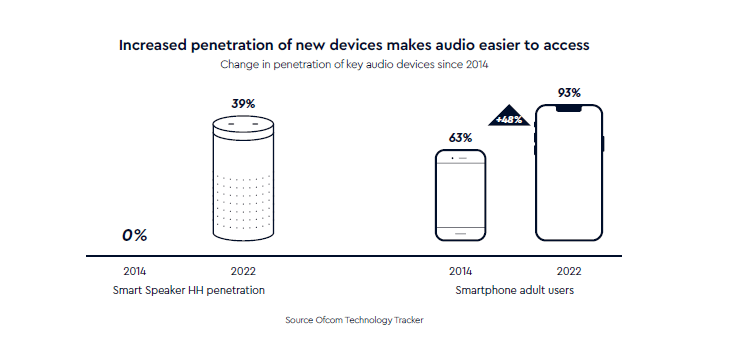
2. Growth in listening results from increased ‘Mental Availability’ of audio (salience)
Mental availability describes how many relevant reasons-to-buy are associated with a particular product or brand. Byron Sharp coined the term ‘category entry points’ to describe these reasons-to-buy; but we may also think about them in terms of consumer need-states.
The need-states are presented on two axes to provide a framework to better understand the drivers of listener behaviour:
i. SOCIAL-PERSONAL: our social needs concern how we relate to other people and/or the wider world rather than being purely about ourselves.
ii. CONTEXT-CONTENT: sometimes we makes choices based on specific content, but at other times it’s all about where we are, who with, and what we’re doing.
The six consumer need-states identified in 2014 were rigorously interrogated during the qualitative phase of this new project, which confirmed their continuing relevance and importance to today’s listener. The latest qualitative research has also revealed how audio is now also being used to meet a brand-new need-state: Keep Me Company.
This new need-state has emerged due to a growing need for companionship caused by changing living arrangements across the recent past, such as ongoing post-pandemic working patterns, coupled with a rise in economic hardship – all of which are impacting frequency of social contact.
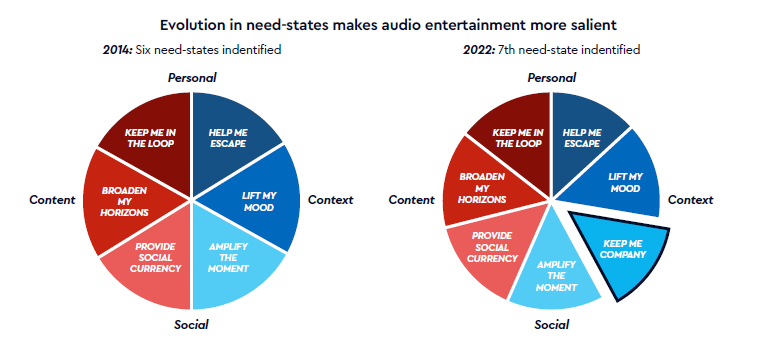
3. Context-led occasions dominate share of commercial listening
At a fundamental level, the qualitative analysis reveals how four of the seven audio need-states are driven primarily by listener context over content (although it should be noted that they are not mutually exclusive concepts – content naturally plays a vital role in context-led listening choices). To supplement this finding, the quantitative phase of the project provided us with data to quantify the relative size of the individual seven need-states, based on the share of total audio listening time each represents. This data is derived from the half million minutes of commercial audio listening that was captured across all respondents during the one-week diary task.
The numbers reveal how share of total listening is even-more skewed towards ‘context-led’ listening occasions, highlighting how people often use audio entertainment to meet needs motivated by circumstances and surroundings. This is partly driven by easy access to audio, wherever and whenever required, but also by the fact that audio is able to flex to fit around people’s daily lives; and can be heard as intended, even when people are engaged in other tasks.
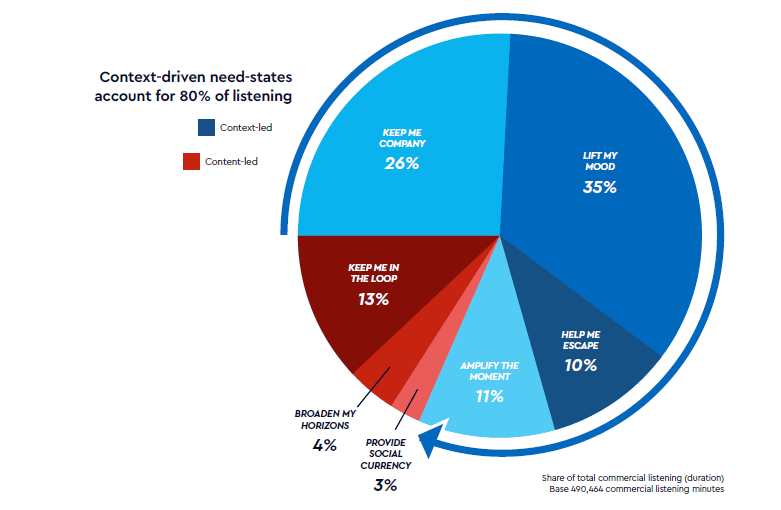
4. Need-states-based planning offers enhanced communications opportunities for advertisers
Editorial context
The impact of radio’s editorial context on audio advertising processing was explored in Radiocentre’s Emotional Multiplier study. This identified that radio’s mood-boosting editorial effect extends into the ad break, enhancing engagement with advertising by 30% compared to when the ads were heard preceded by silence.
Listener context/activity congruence
Behavioural economics suggests how a brand’s goals can be activated by situational cues that lead consumers to make decisions subconsciously.* Radiocentre’s Hear and Now research study reveals how radio advertising that directly relates to tasks or activities that listeners are participating in benefits from significantly higher levels of engagement and memory processing. Further analysis shows how these effects are so powerful that they can turn average ads into star performers.
Building on this insight, Radiocentre’s Building Shelf Awareness study demonstrates how reaching people just prior to the point of purchase (i.e. in-car on their way to the supermarket) can deliver powerful short-term effects, helping brands to stand-out more on-shelf and increasing immediate purchase consideration.
*Non-conscious goals and consumer choice/ Chartrand, Huber, Shiv, Tanner, 2008
Mood congruence
Mood congruence is important for future recall because memory encoding (and therefore earning a spot in a person’s long-term memory) occurs best when the mood of the advertisement matches the person’s mood at
the time.*
* The Role of Emotions in Marketing/Bagozzi, Gopinath, Nyer, 1999
Factors to consider when comparing relevance of individual need-states for different briefs:
• Weekly reach %
• Average length of listening occasion
• Prevalent Listener mood
• Social context of listening
• Main location of listening
• Main activities being undertaken
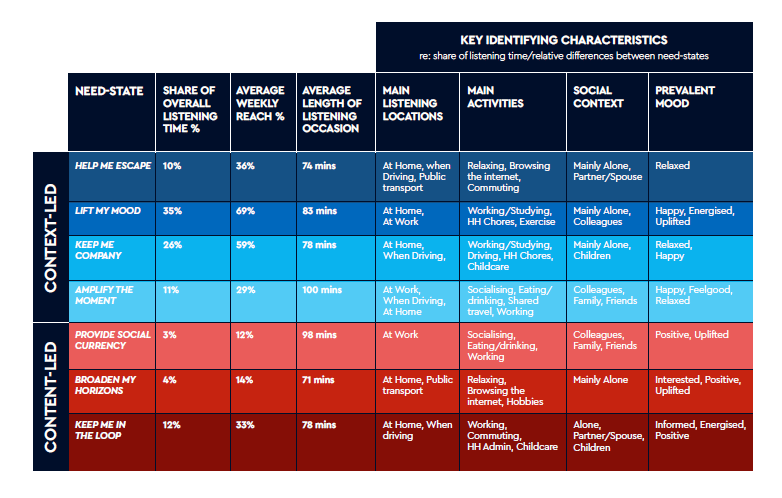
5. Live Radio and on-demand audio formats play complementary roles for listeners
Reviewing share of listening time by need-state for each form of audio entertainment provides a helpful structure for
understanding the relative scale and defining characteristics of the different audio formats.
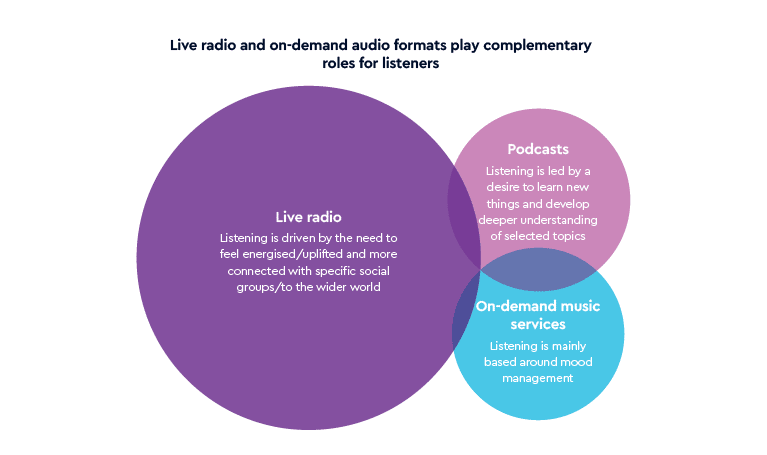
6. Radio has the highest weekly reach and share of listening time within 6/7 need-states
As the chart demonstrates, Live Radio has the highest weekly reach by a number of multiples, dominating within all of the need-states except ‘Broaden my Horizons’, within which podcasts deliver the highest reach. Live Radio is also found to account for the greatest share of time spent listening within each need-state, again with the exception of Podcasts in ‘Broaden my Horizons’.
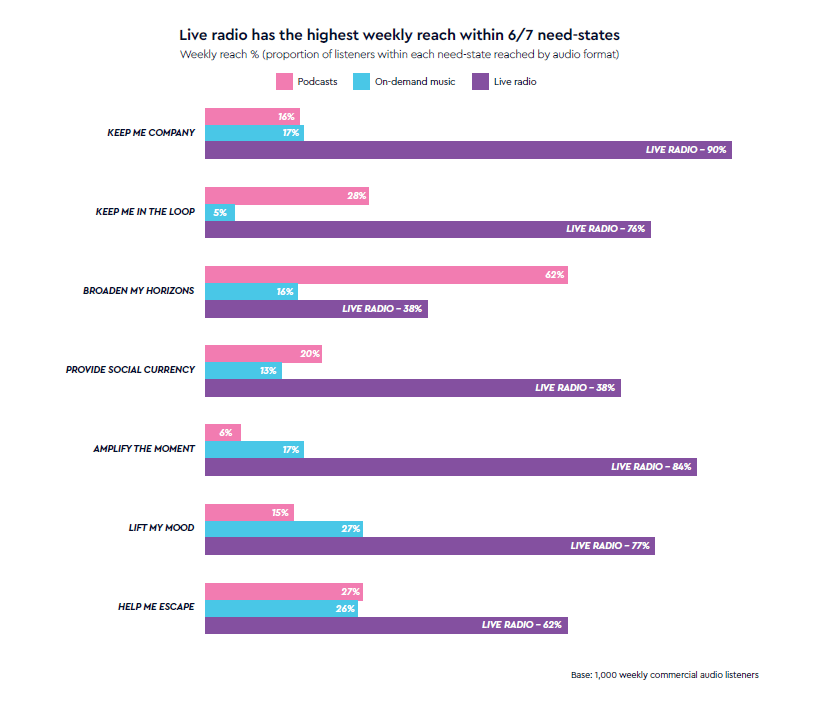
7. Radio leads time spent listening across all demographics
Despite the needs driving listening behaviour/audio choices varying by age, RAJAR MIDAS quantifies how Live Radio continues to lead time spent listening among all adults and younger audience groups.
In summary, with the highest reach and share of listening time across six out of the seven audio need-states, Live Radio remains the most widely listened-to form of audio entertainment – and, therefore, continues to play a crucial role for advertisers for all audiences.
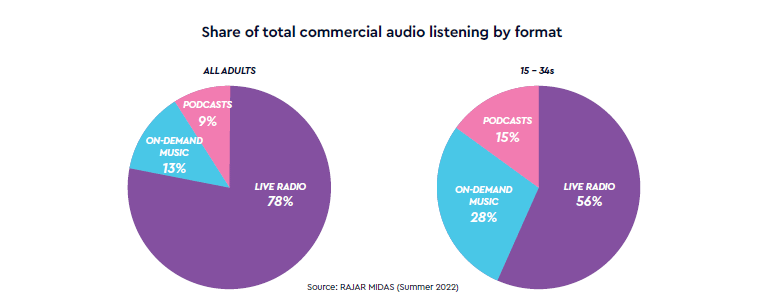
8. Audio needs and associated listening behaviours evolve with age
Analysis of the share of total listening time within each need-state by demographic group reveals how the relevance of individual need-states evolves as listeners get older.
The chart establishes the most prevalent drivers of listening for different demographic groups (relative to all adults). Within these broad trends, individual audio formats meet listeners’ evolving needs in different ways.
Taken in combination, these factors help explain why audio listening choices vary across different demographic groups. Delving further into the audience data for different audio formats within individual need-states helps explain how listening patterns formed at a younger age aren’t rigidly maintained as listeners become older and their lifestyles evolve. This is further evidenced by the continued headline growth in live commercial radio audiences despite the growing popularity of podcasts and streamed music services among younger audiences.
Put simply, as audiences’ audio needs evolve in response to new working and/or domestic situations, so does the portfolio of audio formats they use to meet these needs. In this context, despite seemingly increased competition for share of ear, listening to Live Radio is projected to remain stable for the foreseeable future.
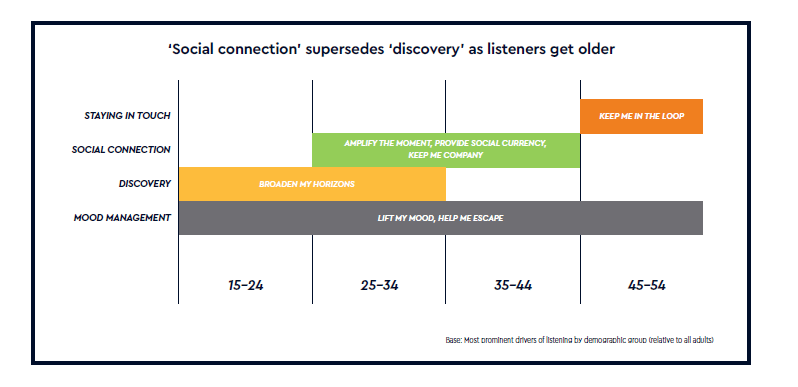
References
IPSOS
Accessible via Radiocentre.org
Radiocentre, Colourtext
Radiocentre, Holmes and Cook
Holmes and Cook, 2013
How Brands Grow
Radiocentre, Neuro-Insight
Radiocentre, Shoppercentric
Radiocentre, Sparkler
Radiocentre, DRG
Global, Differentology
The Long & the short of it
Binet and Field/IPA
How Brands Grow
Professor Byron Sharp/Oxford University Press
The role of emotions in marketing
Bagozzi, Gopinath, Nyer/Journal of the Academy of Marketing Science, 1999
Non-conscious goals and consumer choice
Chartrand, Huber, Shiv, Tanner/ Journal of Consumer Research, 2008
Radiocentre, Differentology



